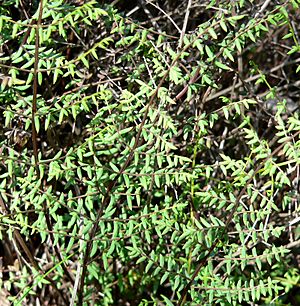Bird's foot cliffbrake facts for kids
Quick facts for kids Bird's foot cliffbrake |
|
|---|---|
 |
|
| Conservation status | |
| Scientific classification |
Pellaea mucronata is a fascinating type of fern that people often call the bird's foot cliffbrake. This name comes from how its leaves look, somewhat like a bird's foot, and where it likes to grow – on rocky cliffs!
This fern is native to many parts of California. You can also find it growing in some areas of Oregon, Nevada, Arizona, and Baja California in Mexico. It loves to make its home in different kinds of rocky places, like mountain slopes or canyon walls. There are two main types, or subspecies, of this fern. One type, called californica, is only found in California. The other type, mucronata, can be found in California and the other states mentioned.
What Does This Fern Look Like?
The leaves of the bird's foot cliffbrake are quite unique. Each leaf can grow to be anywhere from 7 to 45 centimeters long. That's about the length of a ruler! Each leaf grows on a thin stem called a petiole.
Leaf Structure
The main part of the leaf is a thin, straight, brown stem called a rachis. Think of it like the spine of the leaf. Along this rachis, you'll find many small leaflets spaced out. These leaflets are divided into even smaller, narrow sections. Sometimes, these small sections are divided again into even tinier parts!
Leaflet Details
The smallest parts of the leaf are usually about one centimeter long. They can be a bright green color or even a dark purplish shade. The edges of these tiny leaf segments often roll under, which is a special feature of this fern.
How Ferns Reproduce
Like all ferns, the bird's foot cliffbrake reproduces using spores. These spores are like tiny seeds. The sporangia, which are structures that hold the spores, are found hidden under the rolled-under edges of the leaf segments. When the spores are ready, they are released to grow new ferns.
See also
 In Spanish: Pellaea mucronata para niños
In Spanish: Pellaea mucronata para niños


